| BRUCHIPICTURES | BRUCHINEWS | BRUCHIWORKERS |
Knowledge of Hungarian Bruchidae
by György, Zoltán
(Chrysomelidae: Bruchinae)
Leguminous host plants of seed predator seed weevil species in Hungary
Seed beetles
The
most comprehensive publication on the seed beetles of Hungary is a
volume of the series of Fauna Hungariae by Kaszab (1967). In this
faunal work two subfamilies, seven genera, 57 species and 13
infrasubspecific taxa were mentioned to occur in the Carpathian Basin
–
or more exactly, in the „historical” Hungary, which
was much larger
before 1918 than our present-day country. Since then, Bruchela Dejean,
1821 (= Urodon Schönherr, 1823) was removed from
Bruchidae and
transferred to the family Anthribidae or a family of its own. Of the
remaining taxa, 6 genera and 36 species were stated to occur in
present-day Hungary by Kaszab (1967), including Bruchidius picipes
(Germar, 1824) and Bruchidius pusillus (Germar, 1824), which were
treated as infrasubspecific “aberrations” of
Bruchidius seminarius
(Linnaeus, 1767). Further species were recorded by Borowiec (1985),
Jávor (1990), Jermy & Szentesi (2003), Jermy et al.
(2002), Merkl
(1991, 2001), Wendt (1981) and Wendt & Merkl (1986, 1999).
I revised the whole seed beetle material housed in the Hungarian Natural History Museum (Budapest), which served as the basis of Kaszab’s (1967) work. As a result, the following three species need some remarks.
Bruchidius lividimanus (Gyllenhal, 1833) – Kaszab (1967) mentioned several localities of this species from Hungary, but the specimens on which these records were based, actually belong to B. seminarius (Linnaeus, 1767) and B. mulsanti (Brisout de Barneville, 1863). Kaszab listed three infrasubspecific names (aberrations) of this species, and 19 of the specimens determined as „ab. retamae Vogel” proved to be true B. lividimanus. Further specimens were found in the material of the Savaria Museum (see above).
Bruchidius „species prope varius”– Merkl (1991) and Borowiec & Merkl (1993) first reported this species under the name Bruchidius martinezi (Allard, 1868), based on specimens determined by Lech Borowiec in 1990. However, according to Anton (2001), B. martinezi is a species of southwestern Mediterranean distribution, which does not occur in Hungary. The closely related species found in our country is still unidentified. Anton (2001) tentatively used the name Bruchidius species prope varius.
Bruchidius pauper (Boheman, 1829) – Kaszab (1967) reported this species from Budapest and Pécs, based on a male and a female specimen, respectively. However, these are misidentified specimens of Bruchidius olivaceus (Germar, 1824). Nevertheless, Bruchidius pauper cannot be deleted from our faunal list, because it does occur in present-day Hungary (Jermy & Szentesi 2003). Two specimens are deposited in the Hungarian Natural History Museum, which were reared from pods of Coronilla coronata collected in Nagykovácsi (3.IX.1983, leg. Árpád Szentesi, det. Klaus-Werner Anton; 17.VIII.2004, leg. and det. Tibor Jermy). After checking the original specimens, the following eight species should be deleted from the faunal list of Hungary.
Bruchidius astragali (Boheman, 1829) was mentioned by Borowiec & Anton (1993) and Kaszab (1967), but no exact locality was given, and original specimens are not available. Occurrence of this East-Mediterranean-Pontian species in Hungary is quite unlikely.
Bruchidius foveolatus (Gyllenhal, 1833) was mentioned by Kaszab (1967) from Pécs, Simontornya and Siófok. Original specimens from the first two localities are unavailable, and the reliability of the specimen from Siófok is highly doubtful.
Bruchidius longulus Schilsky, 1905 was mentioned by Kaszab (1967) under the synonymous name Bruchidius longus Pic, 1913 from Budapest, but no original specimen is available. Occurrence of this Mediterranean species in Hungary is pretty unlikely.
Bruchidius murinus Boheman, 1829 was mentioned by Kaszab (1967) from the Mecsek Mts, but no original specimen is available.
Bruchidius pygmaeus (Boheman, 1833) was mentioned by (Kaszab 1967) under the name Bruchidius perparvulus (Boheman, 1833) as „fairly rare in the drier steppic slopes of Transdanubia”. However, all specimens proved to be Bruchidius villosus (Fabricius, 1792) (checked by L. Borowiec in 1983).
Bruchidius tibialis Boheman, 1929 was mentioned by Wendt & Merkl (1999) from the Aggtelek National Park (Jósvafő: Nagy-oldal), but the record is based on a misidentified specimen of Bruchidius pubicornis Lukjanovitsh et Ter-Minassian, 1957 (checked by Z. György in 2004).
Bruchus griseomaculatus Gyllenhal, 1833 was mentioned by Anton (1991, 1994), Boroviec (1988) and Kaszab 1967), but original specimens are unavailable, except one specimen, which has two labels with the text „Pest 1859. J. Frivaldszky” and „griseomaculatus Ch. Bris.”, respectively. However, this is not conspecific with true Bruchus griseomaculatus. It has not been identified as yet, but probably belongs to Bruchus luteicornis Illiger, 1794 (checked by Z. György and T. Jermy in 2005). Anton (2001) also emphasises that occurrence of Bruchus griseomaculatus in Hungary is doubtful.
Spermophagus kuesteri Schilsky, 1905 was mentioned by Kaszab (1967) from Budapest and Szentes, but the original specimens belong to Spermophagus sericeus (Geoffroy, 1785) (checked by Z. György in 2004).
In the subsequent list, species without reference were listed by Kaszab (1967). Species recorded after 1967 are followed by a reference in which the species in question was first reported from Hungary. Hungarian names are proposed for all species.
Click for the checklist of Bruchidae: Website
of Zoltán
György (Hungarian seed beetles).I revised the whole seed beetle material housed in the Hungarian Natural History Museum (Budapest), which served as the basis of Kaszab’s (1967) work. As a result, the following three species need some remarks.
Bruchidius lividimanus (Gyllenhal, 1833) – Kaszab (1967) mentioned several localities of this species from Hungary, but the specimens on which these records were based, actually belong to B. seminarius (Linnaeus, 1767) and B. mulsanti (Brisout de Barneville, 1863). Kaszab listed three infrasubspecific names (aberrations) of this species, and 19 of the specimens determined as „ab. retamae Vogel” proved to be true B. lividimanus. Further specimens were found in the material of the Savaria Museum (see above).
Bruchidius „species prope varius”– Merkl (1991) and Borowiec & Merkl (1993) first reported this species under the name Bruchidius martinezi (Allard, 1868), based on specimens determined by Lech Borowiec in 1990. However, according to Anton (2001), B. martinezi is a species of southwestern Mediterranean distribution, which does not occur in Hungary. The closely related species found in our country is still unidentified. Anton (2001) tentatively used the name Bruchidius species prope varius.
Bruchidius pauper (Boheman, 1829) – Kaszab (1967) reported this species from Budapest and Pécs, based on a male and a female specimen, respectively. However, these are misidentified specimens of Bruchidius olivaceus (Germar, 1824). Nevertheless, Bruchidius pauper cannot be deleted from our faunal list, because it does occur in present-day Hungary (Jermy & Szentesi 2003). Two specimens are deposited in the Hungarian Natural History Museum, which were reared from pods of Coronilla coronata collected in Nagykovácsi (3.IX.1983, leg. Árpád Szentesi, det. Klaus-Werner Anton; 17.VIII.2004, leg. and det. Tibor Jermy). After checking the original specimens, the following eight species should be deleted from the faunal list of Hungary.
Bruchidius astragali (Boheman, 1829) was mentioned by Borowiec & Anton (1993) and Kaszab (1967), but no exact locality was given, and original specimens are not available. Occurrence of this East-Mediterranean-Pontian species in Hungary is quite unlikely.
Bruchidius foveolatus (Gyllenhal, 1833) was mentioned by Kaszab (1967) from Pécs, Simontornya and Siófok. Original specimens from the first two localities are unavailable, and the reliability of the specimen from Siófok is highly doubtful.
Bruchidius longulus Schilsky, 1905 was mentioned by Kaszab (1967) under the synonymous name Bruchidius longus Pic, 1913 from Budapest, but no original specimen is available. Occurrence of this Mediterranean species in Hungary is pretty unlikely.
Bruchidius murinus Boheman, 1829 was mentioned by Kaszab (1967) from the Mecsek Mts, but no original specimen is available.
Bruchidius pygmaeus (Boheman, 1833) was mentioned by (Kaszab 1967) under the name Bruchidius perparvulus (Boheman, 1833) as „fairly rare in the drier steppic slopes of Transdanubia”. However, all specimens proved to be Bruchidius villosus (Fabricius, 1792) (checked by L. Borowiec in 1983).
Bruchidius tibialis Boheman, 1929 was mentioned by Wendt & Merkl (1999) from the Aggtelek National Park (Jósvafő: Nagy-oldal), but the record is based on a misidentified specimen of Bruchidius pubicornis Lukjanovitsh et Ter-Minassian, 1957 (checked by Z. György in 2004).
Bruchus griseomaculatus Gyllenhal, 1833 was mentioned by Anton (1991, 1994), Boroviec (1988) and Kaszab 1967), but original specimens are unavailable, except one specimen, which has two labels with the text „Pest 1859. J. Frivaldszky” and „griseomaculatus Ch. Bris.”, respectively. However, this is not conspecific with true Bruchus griseomaculatus. It has not been identified as yet, but probably belongs to Bruchus luteicornis Illiger, 1794 (checked by Z. György and T. Jermy in 2005). Anton (2001) also emphasises that occurrence of Bruchus griseomaculatus in Hungary is doubtful.
Spermophagus kuesteri Schilsky, 1905 was mentioned by Kaszab (1967) from Budapest and Szentes, but the original specimens belong to Spermophagus sericeus (Geoffroy, 1785) (checked by Z. György in 2004).
In the subsequent list, species without reference were listed by Kaszab (1967). Species recorded after 1967 are followed by a reference in which the species in question was first reported from Hungary. Hungarian names are proposed for all species.
György,
Z. & Merkl, O. (2005): Seed beetles preserved in the Savaria
Museum, Hungary, with a National Checklist of the family (Coleoptera:
Bruchidae) – Praenorica Folia Historico-Naturalia 8:
65–78 

Bruchus Linnaeus, 1767 |
|
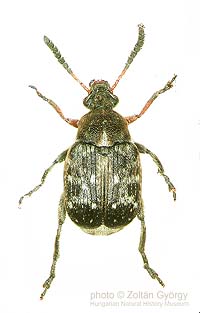 |
Host
plant in Hungary
(Jermy et Szentesi, 2003) Lathyrus latifolius L. Lathyrus pratensis L. Lathyrus sylvestris L. Lathyrus tuberosus L. |
| Bruchus affinis Frölich, 1799 | |
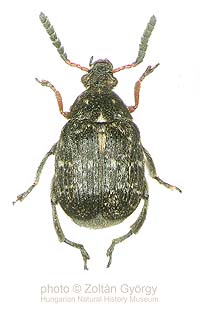 |
Host plant in
Hungary (Jermy et Szentesi, 2003) Lathyrus latifolius L. Lathyrus niger (L.) Lathyrus pannonicus (Jacq.) Lathyrus sylvestris L. Lathyrus vernus (L.) Vicia cassubica L. Vicia pisiformis L. Vicia sepium L. Vicia sparsiflora Ten. |
| Bruchus atomarius
(Linnaeus, 1761) |
|
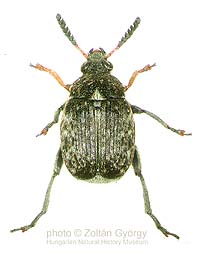 |
Host plant in Hungary (Jermy et Szentesi, 2003) Vicia tenuifolia Roth Vicia villosa |
| Bruchus
brachialis Fahraeus, 1839 |
|
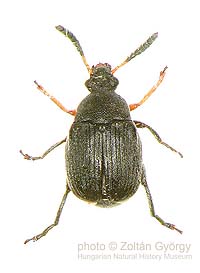 |
Host
plant in Hungary (Jermy et Szentesi, 2003) Lathyrus nisolia L. Lathyrus pratensis L. |
| Bruchus loti
Paykull, 1800 |
|
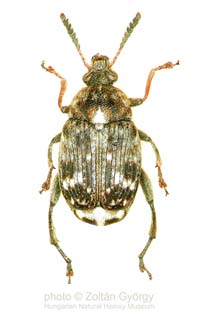 |
Host plant in
Hungary (Jermy et Szentesi, 2003) Pisum sativum L. |
| Bruchus pisorum
(Linnaeus, 1758) |
|
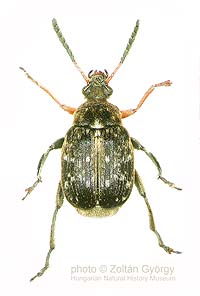 |
Host plant in
Hungary (Jermy et Szentesi, 2003) Vicia pannonica ssp. pannonica Cr. Vicia pannonica ssp. striata (M. B.) |
| Bruchus rufimanus
Boheman, 1833 |
|
| Host plant in Hungary (Jermy et Szentesi, 2003) Vicia cracca L. Vicia tenuifolia Roth |
|
|
Bruchus occidentalis
Lukjanovitsh et Ter-Minassian, 1957 (original photo by Z. György) |
|
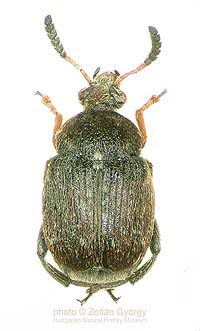 |
Host plant in
Hungary (Jermy et Szentesi, 2003) Lathyrus hirsutus L. Lathyrus odoratus |
|
Bruchus tristiculus
Fahraeus, 1839
|
|
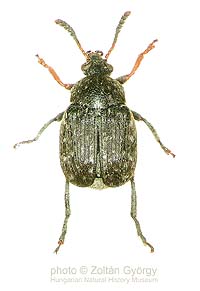 |
Host plant in
Hungary (Jermy et Szentesi, 2003) Vicia cracca L. Vicia tenuifolia Roth |
|
Bruchus venustus
Fahraeus, 1839
|
|
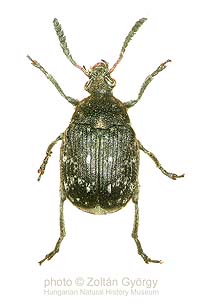 |
Host plant in
Hungary (Jermy et Szentesi, 2003) Lathyrus niger (L.) Lathyrus pannonicus (Jacq.) Lathyrus pratensis L. |
|
Bruchus viciae Olivier,
1795
|
|
Bruchidius Schilsky, 1905 |
|
|
Host plant in
Hungary (Jermy et Szentesi, 2003) Trifolium pratense L. Trifolium striatum L. |
|
| Bruchidius dispar (Gyllenhal,
1833) (original photo by Z. György) |
|
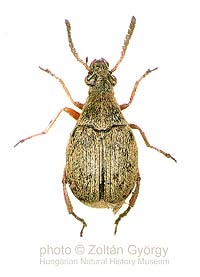 |
Host plant in
Hungary (Jermy et Szentesi, 2003) Glycyrrhiza echinata L. |
| Bruchidius glycyrhizae
(Fahraeus, 1839) = peregii Hajóss, 1937 |
|
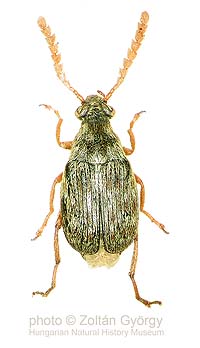 |
Host plant in
Hungary (Jermy et Szentesi, 2003) Galega officinalis L. |
| Bruchidius imbricornis
(Panzer, 1795) |
|
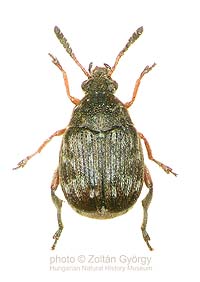 |
Host plant in
Hungary (Jermy et Szentesi, 2003) Cytisus scoparius |
| Bruchidius lividimanus
(Gyllenhal, 1833) |
|
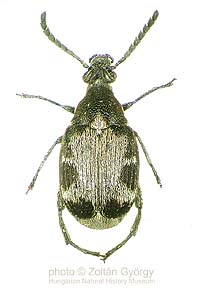 |
Host plant in
Hungary (Jermy et Szentesi, 2003) Astragalus glycyphyllos L. |
| Bruchidius marginalis
(Fabricius, 1775) |
|
|
Host plant in
Hungary (Jermy et Szentesi, 2003) Trifolium fragiferum L. |
|
| Bruchidius
species prope varius sensu ANTON
(2001) = martinezi of authors, not Allard, 1868 |
|
|
Host plant in
Hungary (Jermy et Szentesi, 2003) Coronilla coronata Nath. |
|
| Bruchidius pauper (Boheman,
1829) |
|
| Host
plant in Hungary (Jermy et Szentesi, 2003) Trifolium striatum L. |
|
| Bruchidius picipes
(Germar, 1824) |
|
|
Host plant in
Hungary (Jermy et Szentesi, 2003) Anthyllis vulneraria ssp. polyphylla Onobrychis arenaria (Kit.) |
|
| Bruchidius poupillieri
(Allard, 1868) |
|
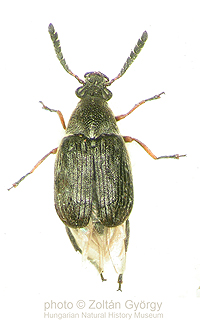 |
Host plant in
Hungary (Jermy et Szentesi, 2003) Coronilla varia (L.) |
| Bruchidius pusillus
(Germar, 1824) |
|
|
Host plant in
Hungary (Jermy et Szentesi, 2003) Tetragonalobus maritimus (L.) |
|
| Bruchidius seminarius
(Linnaeus, 1767) |
|
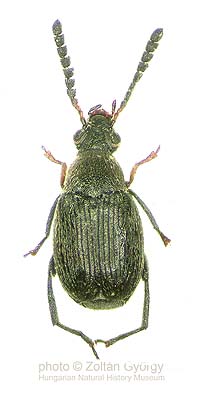 |
Host plant in
Hungary (Jermy et Szentesi, 2003) Trifolium rubens L. |
| Bruchidius sericatus (Germar,
1824) |
|
|
Host plant in
Hungary (Jermy et Szentesi, 2003) Astragalus asper Wulf. in Jacq. Astragalus onobrychis L. Astragalus varius Gmel. Astragalus vesicarius L. Oxytropis pilosa (L.) |
|
| Bruchidius varipes
(Boheman, 1839) |
|
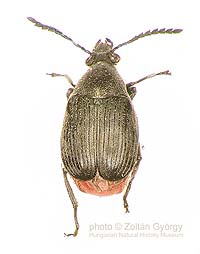 |
Host plant in Hungary (Kergoat et al., 2007) Cercis siliquastrum L. |
|
Bruchidius siliquastri (A. Delobel, 2007) |
|
|
Host plant in
Hungary (Jermy et Szentesi, 2003) Trifolium alpestre L. Trifolium diffusum Ehrh. Trifolium medium Grufbg. Trifolium pratense L. Trifolium rubens L. |
|
| Bruchidius varius (Olivier,
1795) |
|
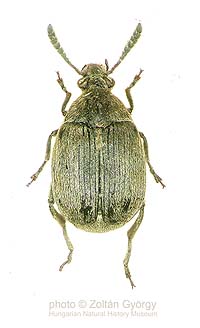 |
Host plant in Hungary (Jermy et Szentesi, 2003) Chamaecytisus hirsutus Link Chamaecytisus supinus (L.) Cytisus scoarius L. Cytisus sessilifolius Genista pilosa L. Genista tinctoria L. Laburnum anagyroides Medic. Petteria ramentacea Spartium junceum L. |
| Bruchidius villosus (Fabricius,
1792) |
|
Megabruchidius Borowiec, 1984 |
|
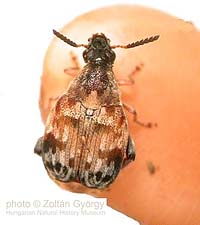 |
Host plant in Hungary (Jermy et al. 2002), (György, 2007) Gleditsia caspica Gleditsia delavai Gleditsia ferox Gleditsia japonica Gleditsia macroacantha Gleditsia triacanthos Gymnocladus dioicus More information from M. tonkineus |
| Megabruchidius tonkineus
(Pic, 1904) |
|
|
Acanthoscelides Schilsky, 1905
|
|
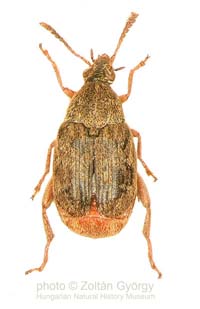 |
Host
plant in Hungary |
| Acanthoscelides obtectus
(Say, 1831) |
|
| Host
plant in Hungary (Wendt, 1981) |
|
| Acanthoscelides
pallidipennis
(Motschulsky, 1874) |
|
| Pests of stored legumes which have not been established but found at least once in Hungary | |
|
Amblycerus Thunberg, 1815
|
|
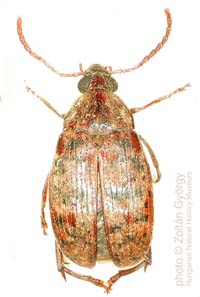 |
Remarks (Merkl 2001), (György, 2007) In Hungary, this species was
observed once, introduced with Gleditsia inermis
seeds from North America.
|
| Amblycerus robiniae
(Fabricius, 1781) |
|
|
Pachymerus Thunberg, 1805
|
|
| Remarks |
|
| Pachymerus pallidus (Olivier, 1790) = acaciae Gyllenhal, 1833 |
|
|
Callosobruchus Pic, 1902
|
|
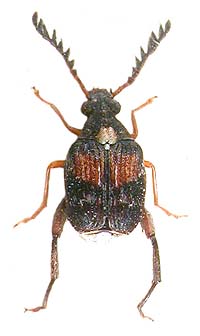 |
Remarks |
| Callosobruchus chinensis
(Linnaeus, 1758) |
|
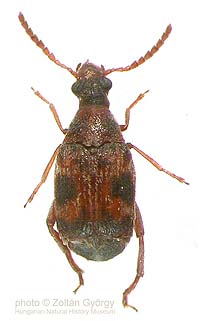 |
Remarks |
| Callosobruchus maculatus
(Fabricius, 1775) |
|
|
Mimosestes Bridwell, 1946
|
|
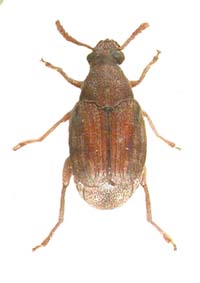 |
Remarks |
| Mimosestes mimosae
(Fabricius, 1781) |
|
|
Zabrotes Horn, 1885
|
|
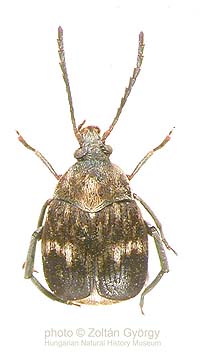 |
Remarks |
| Zabrotes subfasciatus (Boheman,
1833) |
|
Reference
ANTON, K.-W. (2001):
Bemerkungen zur Faunistik und Taxonomie mitteleuropäischer
Samenkäfer (Coleoptera: Bruchidae). – Folia
entomologica hungarica 62: 43–49.
KERGOAT, G. J., DELOBEL P. & DELOBEL, A. (2007): Phylogenetic relationships of a new species of seed-beetle infesting Cercis siliquastrum L. in China and Europe (Coleoptera: Chrysomelida: Bruchinae: Bruchini) – Annales de la Societe Entomologique de France 43 (3): 265–271
GYÖRGY, Z (2007): To the biology of the honey locust seed beetle, Megabruchidius tonkineus (Pic, 1904) (Coleoptera: Chrysomelidae: Bruchinae) – Folia Entomologica Hungarica 68: 89–96. pdf
JABLONOVSKI, J (1920): A közönséges paszulyzsizsik. Köztelek, 30: 138-139, 157-158.
JERMY, T., SZENTESI, Á. & ANTON, K.-W. (2002): Megabruchidius tonkineus (Pic, 1904) (Coleoptera: Bruchidae) first found in Hungary. – Folia entomologica hungarica 63: 49–51. pdf
JERMY, T. & SZENTESI, Á. (2003): Evolutionary aspects of host plant specialisation -- a study on bruchids (Coleoptera: Bruchidae). Oikos, 101: 196-204.
MERKL, O. 2001: Rovarküldöttek. [Insect emissaries.] – ÉlÅ‘világ 10: 12–17.
WENDT, H. (1981): Eine für Südost-Europa neue Samenkäfer-Art (Coleoptera: Bruchidae). – Folia entomologica hungarica 42: 223–226.
KERGOAT, G. J., DELOBEL P. & DELOBEL, A. (2007): Phylogenetic relationships of a new species of seed-beetle infesting Cercis siliquastrum L. in China and Europe (Coleoptera: Chrysomelida: Bruchinae: Bruchini) – Annales de la Societe Entomologique de France 43 (3): 265–271
GYÖRGY, Z (2007): To the biology of the honey locust seed beetle, Megabruchidius tonkineus (Pic, 1904) (Coleoptera: Chrysomelidae: Bruchinae) – Folia Entomologica Hungarica 68: 89–96. pdf
JABLONOVSKI, J (1920): A közönséges paszulyzsizsik. Köztelek, 30: 138-139, 157-158.
JERMY, T., SZENTESI, Á. & ANTON, K.-W. (2002): Megabruchidius tonkineus (Pic, 1904) (Coleoptera: Bruchidae) first found in Hungary. – Folia entomologica hungarica 63: 49–51. pdf
JERMY, T. & SZENTESI, Á. (2003): Evolutionary aspects of host plant specialisation -- a study on bruchids (Coleoptera: Bruchidae). Oikos, 101: 196-204.
MERKL, O. 2001: Rovarküldöttek. [Insect emissaries.] – ÉlÅ‘világ 10: 12–17.
WENDT, H. (1981): Eine für Südost-Europa neue Samenkäfer-Art (Coleoptera: Bruchidae). – Folia entomologica hungarica 42: 223–226.

